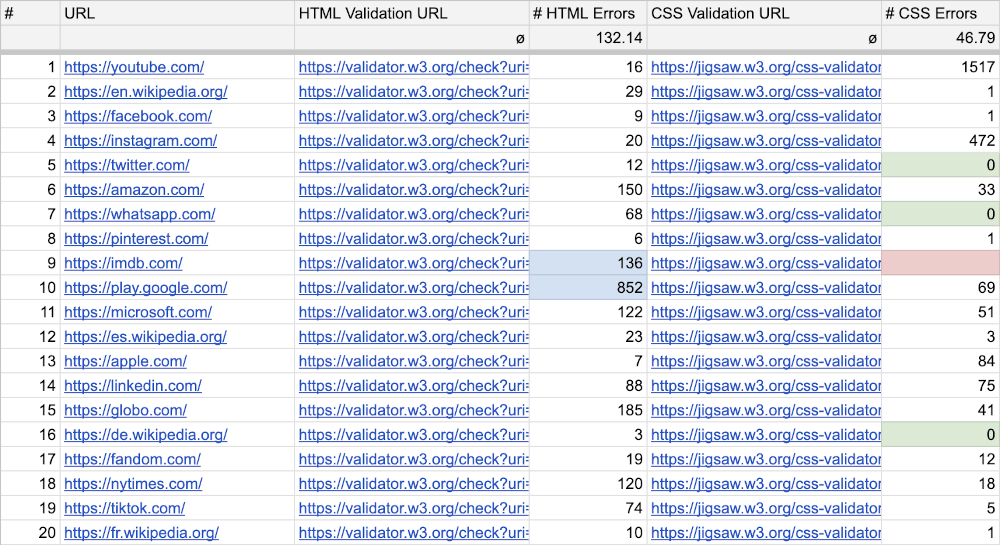2023: 0 of the Global Top 100 Websites Use Valid HTML
Published on Oct 31, 2023 (updated Sep 14, 2024), filed under development, html, css, conformance. (Share this post, e.g. on Mastodon or on Bluesky.)
For the latest analysis, check out the data for 2025.
Let’s dive right in: Nothing changed compared to last year—none of the 100 most-visited websites globally uses HTML in full conformance with the HTML specification.
The following data gives an impression of precision that is greater than warranted. The point of this annual analysis is to check on full HTML conformance (absence of markup errors); that is, CSS conformance checks are a bonus, and the specific error counts don’t matter for the purpose of telling conformance or non-conformance, either. I’m providing the data for further study, and for comparability to previous years.
Analysis
After 2021 and 2022, I used the annual update of the Ahrefs Top 100 websites to check the homepages of these websites on HTML conformance.
For that purpose I took all the respective URLs, prepared HTML and CSS validation URLs, and documented the error counts of the 200 tests in a spreadsheet:
HTML Conformance in 2023
0 of the 100 websites have 0 HTML conformance errors.
3 (Adobe, Speedtest, and Spotify) were very close to conformance, with 1 error each. 14 more had a single-digit number of issues.
37 were far away from conformance with any specification (100 or more errors).
The average number of HTML errors is 132.14.
The HTML errors median is 62.
(The mode is 23.)
CSS Conformance in 2023
The W3C CSS validator needs updating. There appear to be many false positives (and a suspicion of false negatives), raising concern that the results aren’t practically useful anymore (perhaps not even for ballpark numbers). CSS conformance isn’t as critical as HTML conformance, but it’s important for us to have a reliable CSS validator.
12 of 94 tested websites have 0 CSS conformance errors. (6 websites could not be checked.)
34 were close to conformance, with a single-digit number of errors.
7 were far away (100 or more errors, with one site containing more than 1,000 errors).
The average number of CSS errors is 46.79.
The median is 10.5.
(The mode is 0.)
HTML and CSS Conformance Over Time
We need to test more websites to make this significant, but given that this has been the third analysis, here is how error counts developed over the years:
| 2021 | 2022 | 2023 | |
|---|---|---|---|
| HTML | ø 125.22 errors | ø 125.63 errors → | ø 132.14 errors ↗ |
| 2 homepages without errors | 0 homepages without errors ↘ | 0 homepages without errors → | |
| CSS | ø 48.40 errors | ø 26.33 errors ↓ | ø 46.79 errors ↑ |
| 3 homepages without errors | 13 homepages without errors ↑ | 12 homepages without errors → |
Interpretation
I think the results speak for themselves.
Personally, I’m vocal about the usefulness of conformance—I think it’s foundational for our field, that it should be a hiring criterion, and that it could unite us to tackle other important challenges. (If you’re interested, I also run an ebook series—check out the latest edition—explaining and promoting valid, minimal HTML.)
While that’s me, even during the years of the Web Standards Project (1998–2013), our field has neither accepted this nor any other quality standard for its output.
We can use every developer to improve this—lead by example and ship valid code—, but going by the data, there’s no change in sight.
About Me
I’m Jens (long: Jens Oliver Meiert), and I’m a web developer, manager, and author. I’ve been working as a technical lead and engineering manager for companies you’ve never heard of and companies you use every day, I’m an occasional contributor to web standards (like HTML, CSS, WCAG), and I write and review books for O’Reilly and Frontend Dogma.
I love trying things, not only in web development and engineering management, but also in other areas like philosophy. Here on meiert.com I share some of my experiences and views. (I value you being critical, interpreting charitably, and giving feedback.)

